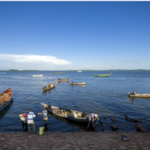The Social and Historical Characteristics of the Two Clans on Ijwi
The previous section examined the content of each of the two traditions for its consistency and historical plausibility. Their differences can be explained in part by the fact that the two traditions are so localized on the island today; each tra-dition is associated only with a single, rather small clan. This section considers the characteristics of each of those clans that relate to the content or form of the tradition as it is held today.
Understanding the historical roles of the two clans, particularly their relationships with the royal family, contributes to our understanding of the traditions, just as the traditions in some ways provide an explanation for those historical roles. Yet it is not a common sociological device for clans on Ijwi to relate present situations or past glories to an earlier history of ties with the royal family. Indeed, the Babambo and Baloho—the two clans involved with these genesis traditions—are the only clans on Ijwi that have such traditions; it is a rare narrator from another clan who offers any account of royal arrival beyond the most succinct (and often etiological) statement of the fact of arrival itself. Consequently, genesis traditions of this sort on Ijwi cannot be seen as a common structural device to explain or justify present status or subsequent events.
The different forms of the two traditions can be accounted for by three fac-tors: the different milieux within which these two groups functioned, their pre-Ijwi cultural heritage, and their subsequent history on Ijwi. Many of the dominant literary elements in each tradition reflect or reinforce the social characteristics predominating in the areas of settlement of each group. The Babambo, for example, lived in an area of more intense social interaction and political conflict over the past 150 years than did the Baloho; they also live today in an area more heavily influenced by Rwandan cultural values (as since the mid-nineteenth century, Kinyaga has become increasingly integrated into the Rwandan state). Consequently it is not surprising that intense social interaction and conflict, and frequent Rwandan contacts and literary style (e.g., the “orphan-king” theme), are two characteristics prominent in the Babambo tradition. On the other hand, the Baloho today live in an area of relatively high clan autonomy. Therefore, it is not surprising that in narrating their relations with Mwendanga, these narratives do not identify any other specific clans (or other individuals aside from Kabwiika, Mwendanga, and Kamo). Furthermore, the Baloho settlement area is more compatible with the preservation of forest-type cultural values and literary traditions, of which the “sack theme” is one.
As emphasized in the traditions, Baloho and Babambo collectively associate their own arrival and presence on Ijwi with the arrival of the royal heir. But the Baloho have no local power base independent of the Basibula dynasty; their status and significance stem exclusively from their asserted ties to Mwendanga and his successors. The primary areas of Babambo residence, on the other hand, are located on the mainland, on both eastern and western shores at the southern end of the lake. On Ijwi, the Babambo are concentrated in the lakeshore areas in the southwest of the island, facing the areas of Babambo strength on the mainland. Indeed, this part of the lake is intersected by numerous inter-locking peninsulas and small islands, a geographical fact reflected socially in intensive interaction, interchange, and communication between the lakeshore areas. Because they share in this general mobility, the Babambo on Ijwi have maintained relatively close ties with their mainland relatives.
Babambo political strength in the mainland areas seems to have consider-able historical depth, as the tradition implies by their role in Kabwiika’s succession struggle and the subsequent war against Kamerogosa. In addition, other Ijwi and mainland traditions refer to a later succession dispute on Ijwi that is better understood when the Babambo locus of power on the mainland is accounted for. At the time of Mwendanga’s death, one of the claimants to the throne was Vuningoma, Mwendanga’s son by a Babambo wife; some say Vuningoma was Mwendanga’s first-born son, nfula. The term nfula, however, has an ambiguous meaning in this patrilineal society, since in addition to “first-born son” it also carries the meaning of “successor,” and in fact, this is often its primary meaning; a man who succeeds his father is referred to as his nfula, regardless of the position of his birth. Therefore, some informants also imply that Vuningoma was designated (or at least favored) as heir to Mwendanga’s throne—just as his grandfather, Kabwiika, had been before him, according to some accounts.However, in part because of the arrogance of the Babambo on Ijwi,continue these narratives, Vuningoma was rejected by the “population” on Ijwi. (While it is not clear which segments of the population this refers to, it is significant that internal popular pressure is presented as having played such an important role in the Ijwi succession disputes).
The succession finally went to Kabego, a son of Mwendanga by a different mainland wife. Kabego, however, had lived on Ijwi, while Vuningoma had remained on the mainland, at a peninsula called Rambira, near Ishungu. The succession dispute, apparently of long duration, seems to have been essentially a struggle between the mainland areas of Mwendanga’s domain and Ijwi, with Vuningoma and the mainland areas represented primarily by the Babambo. Finally, the traditions state, the Bany’Iju under Kabego rounded up all the Babambo on Ijwi and placed them on a tiny island located between Ijwi and the mainland. Those who could not escape were slaughtered to a man. Since then, only a few Babambo have remained on Ijwi, in their capacity as ritual maternal uncles to the king; they have not been seriously involved in the power equation of Ijwi Island.
The minimal social status of the Babambo on Ijwi today, therefore, is very different from the glory portrayed in the Kabwiika-Mwendanga tradition; the genesis tradition that relates the Babambo to royal status certainly does not serve the role of a “social charter” explaining or justifying their current (limited) pres-ence and status on Ijwi. In fact, the two aspects of the tradition relating to the Babambo (that of Mwendanga’s youth and that of the succession struggle follow-ing Mwendanga’s death) are quite distinct: they are never run together into one continuous narrative, and while other clans know almost nothing of the Babambo genesis tradition, the tradition of Kabego’s“pogrom”against the Babambo is more widely known and recounted. It could be said that the Babambo tradition—with all its detail—is no more than an attempt to assert distant glories in the face of more recent disaster. However, this interpretation does not account for its presence on the mainland, among people who are concerned with the intricacies of nineteenth-century internal Ijwi succession struggles.
The interpretation of the Babambo tradition as “social charter,” simply an attempt to augment their status, would not also explain their ritual role as maternal uncles, a role widely accepted on Ijwi even by those unfamiliar with the Babambo tradition. Furthermore, it would not seem necessary for the Babambo to assert a totally fictive tradition to claim their ritual role—other clans do not, and they suffer no more status deprivation than the Babambo. In fact, as mentioned above, neither the Babambo nor Baloho enjoy a particularly high status on Ijwi today. In short while low status may account for the retention of a tradition, it seems hardly to have been responsible for having created it. Nor would it seem plausible that Babambo strength off Ijwi was responsible for the emergence of a tradition to explain that (former) status: Ijwi kingship is of little importance to those off the island, and mainlanders are not generally informed onIjwi history or politics. It seems incongruous that a tradition concerning an area of little importance (if not also one subject to some disdain)—Ijwi Island— evolved in order to justify status in an area supposedly of greater importance to the Babambo (their mainland strongholds).
The Baloho, on the other hand, are concentrated in a very different part of the island—the eastern highlands (referred to here simply as “the east” for convenience. This mountainous forest area has served to make them much more isolated from formal contacts outside Ijwi than were the Babambo. Curiously, it was also an area relatively isolated from royal presence until recently. Furthermore, the ecology of their area of settlement on Ijwi is notably similar to that of their immediate origin among the Tembo peoples west of the Mitumba Mountains,and in certain cultural aspects the highland areas on Ijwi differ from other areas on the island, even while they approach forest-culture norms.As discussed below in more detail, the form of the Baloho tradition as well as the imagery contained within it are similar to traditions in other areas of Tembo influence but are not common in other Ijwi traditions today; elements in this category include the “sack” theme, the prominent significance of individual mobility, and the achieved “friendship” status between Kamo and Kabwiika. It is possible therefore that this cultural microenvironment that distinguishes the eastern highland areas from other areas of Ijwi has also helped preserve forms of oral literature that would not have been retained.
It is political factors, however, that explain Baloho settlement in the east, if the general orientation of the story is to be believed. In an informal manner, the Baloho appear to have represented the Ijwi royal line in this area during most of the nineteenth century, tied to royalty through Kamo’s original “friendship” with Mwendanga and reinforced by frequent marriages between the Baloho and the royal family.The east in general represented a difficult area in the process of political integration to the new kingdom; it was in this region that groups from east of the lake (from areas today included as part of Rwanda) had settled in sev-eral autonomous communities prior to Basibula arrival. Some of these settlements appear to have maintained strong social and economic ties with their home areas east of the lake, and their oral accounts indicate that on Ijwi they initially had relatively few contacts with each other (or at least that these were not seen as socially significant).Although for the most part these settlements preceded the Basibula, many of them were formed by relatively recent immigrants at the time of Mwendanga’s arrival; this fact, along with their continuing ties off Ijwi, provided them with a ready alternative to direct submission to the new dynasty. In fact, the east was one of the few areas on the island where there appears to have been any overt resistance to Basibula arrival; Mwendanga is said to have driven a segment of the Banyakabwa clan from this area off Ijwi, to the eastern shore of the lake.
There was an added ambiguity to relations between the royal family and the eastern highlands, however. In addition to this being an area of prior settlement by relatively well-defined social units, several of these groups claimed historical ties to ritual groups associated with royalty in Rwanda, related both to the First Fruits ceremonies and to an identification with the royal drum. This fact probably provided these clans (and by extension the area of their settlement) with an added appeal—and potential danger—in the eyes of a new dynastic line such as the Basibula on Ijwi. The east, therefore, was a part of the island that the Basibula treated with some caution—and some distance: members of the royal family did not settle in the east until after colonial rule had been established one hundred years later.
In this context, the Baloho appear to have served as intermediaries between the east and the royal court; even today they are spread among several villages of the east, where they have in the past served as designated village headmen, named by the court in numbers disproportionate to their population size.Some Baloho from this area (such as Camukenge Bitaha) became the most trusted partisans to the kings in the late nineteenth and early twentieth centuries. Indeed, some reports go even further, to imply that the early Baloho held certain royal rituals of their own and that they may have functioned as a sort of counter-dynasty in this region.
But the brilliant history of precolonial ties between the Baloho and the royal family did not survive the new context of colonial rule. The eastern part of the island suffered heavy losses from devastating cattle raids and labor demands that accompanied the imposition of colonial rule on the island, and Baloho prestige declined accordingly. Some Baloho apparently fled; cut off from more recent immigration, the Baloho remain today a relatively small group on Ijwi. Their former sociopolitical status is much eroded, retained only in a few peripheral vil-lages of the area; the more important central villages have been lost to them in the recent administrative reshuffles associated with colonial rule.
Despite their small numbers and diminished status, the Baloho historical role as royal intermediaries to a remote but important region is significant, for the Baloho are apparently the only clan on Ijwi to have served in this role. Certainly, other clans were close to the royal family, and other individuals served inthe same eminent capacity as men such as Camukenge and Shankulu (both Baloho), but no other early clan on Ijwi maintained such a politically significant role for so long or developed such a strong collective identification from their relationship to the kings. Baloho coherence and autonomy deriving from this is ap-parent even today in their sense of a strong corporate feeling: virtually all Baloho on Ijwi claim descent from Kamo, Kabwiika’s friend, who (may have) arrived on Ijwi with Mwendanga. Indicative of this, Baloho informants are able to cite genealogical ties wider and deeper than members of most other clans on Ijwi.
Thus, despitetheir differences in form and content, the two distinct genesis traditions share the common attribute of explaining subsequent roles played by the two groups in Ijwi history. In turn, these later historical roles help explain the presence or retention of the two traditions; but this fact does not explain their content, and especially not their clear limitations. The Babambo tradition helps clarify the events of the struggle between Vuningoma and Kabego to succeed Mwendanga. A knowledge of the depth and nature of Babambo relations with Kabwiika (and especially with Mwendanga) helps cast the nature of subsequent Babambo ties with Vuningoma into more satisfying perspective. Similarly, their political involvement and willingness to fight for political ends, characteristics that appear so strongly in the Babambo genesis tradition, are additional factors in understanding the succession struggle. But the genesis tradition is not merely a prologue to the succession disputes, as we have seen; the two traditions are quite different in their distribution on Ijwi. Finally, Babambo strength on the mainland, something so apparent in the genesis tradition, adds an important dimension to the tradition of the succession struggle that is not otherwise ap-parent; supplementing the theme of personal competition, it explains the succession struggle as a regional struggle between the two domains of Mwendanga’s influence—Ijwi Island and the mainland.
Similarly, the Baloho genesis tradition serves as a justification of later Baloho influence and authority, and therefore approaches more closely the form and function of the conventional “social charter.” For although the Babambo tradition does justify the Babambo role as maternal uncles to the king, it does less to “justify” the succession dispute than explain it, since the arrival trope and the succession trope (the Kabwiika-Mwendanga episode, a father-son narrative) are not directly linked to the Mwendanga-Vuningoma episode (a father-son narrative of the next generation). Nonetheless, the Baloho tradition—as far as it goes—does explain as well as justify, and the two functions cannot be said to bemutually exclusive in this case. If justifying the current order is the main function of a social charter, then this applies more fully to the Baloho tradition than to the Babambo tradition.
The different structures of the two traditions can be largely accounted for by the different milieux in which these two groups lived and in which their traditions functioned, by their pre-Ijwi cultural heritage (the Babambo within the Rwandan cultural orbit, the Baloho within a forest-culture environment), and by their subsequent histories on Ijwi. Many of the dominant elements in each tradition can be seen to reflect or reinforce the social characteristics predominating in each group’s principal area of settlement. The Babambo lived in an area of much greater social interaction and much more intense political conflict than did the Baloho; they have also intensified their ties with Rwandan cultural values as their ancestral area has been increasingly integrated into the Rwandan state. And indeed, both conflict and Rwandan contacts are prominent features in the Babambo tradition. The Baloho, on the other hand, lived in an area of relatively high clan autonomy on Ijwi, one also compatible with the preservation of forest-type cultural values and traditions. Their tradition makes mention of but few other clans, and the themes appearing in them are those of forest cultures, as noted above.
Thus, it seems that the traditions are retained and narrated in their present form in part because they are compatible with both the present and earlier cultural contexts of the people who narrate them. In this sense their historicity—as traditions referring to a specific series of unique historical events, and as handed down from the time of those events—is open to question. Their different forms and their differing (and mutually exclusive) versions of the events of Sibula arrival can be ascribed to their function as independent “social charters” attempting to recoup some of the disastrous decline in status that the two clans have experienced over the past century.
But there are limits to the degree to which such a monolithic functionalist interpretation can be pressed. Other aspects of these traditions may indicate that they are more than simply literary expressions of cultural values or products of contemporary social and political factors, although their retained forms can be viewed in such terms. The very differences in the traditions, differences that some would say negate any potentiality for their use as historical sources, offer the possibility for others to penetrate beyond form and structure and seek out content. In fact, the traditions need not be identical to refer to a single set of events. Rather than factoring out what is similar, we shall try to analyze events from what is different in these two traditions. In fact, the variant narrative elements of the two traditions can be seen—within their limitations—to provide acceptable historical accounts of the particular events associated with royal ar-rival on Ijwi.
While not denying the influence of present or past factors on the form of the traditions, as noted in here, the next section will attempt to go beyond this. For the essential question—whether they reflect history (i.e., the interpretation of past events significant for the present) or whether they reflect present cultural and social conditions and perceptions—need not be answered in exclusive terms: the traditions can serve both functions. We saw above how they conform to the latter possibility; the succeeding section will attempt to determine if, and how, they fulfill the former.
https://uk.amateka.net/the-social-and-historical-characteristics-of-the-two-clans-on-ijwi/https://uk.amateka.net/wp-content/uploads/2023/12/kivu.pnghttps://uk.amateka.net/wp-content/uploads/2023/12/kivu-150x150.pngHistory of kingsSocial & cultureThe previous section examined the content of each of the two traditions for its consistency and historical plausibility. Their differences can be explained in part by the fact that the two traditions are so localized on the island today; each tra-dition is associated only with a single, rather small...BarataBarata rpierre@ikaze.netAdministratorAMATEKA | HISTORY OF RWANDA




